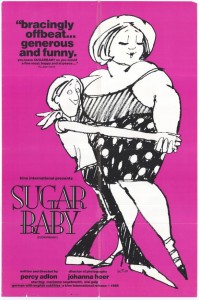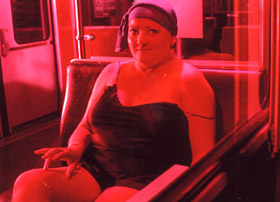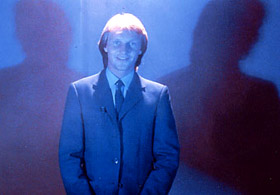“I spied on you, I tracked you down — and then I nailed you!”
|

Synopsis:
A lonely, overweight mortuary employee (Marianne Sagebrecht) falls obsessively in love with a handsome young subway driver (Eisi Gulp), and plots to ensnare him romantically.
|
|
Genres, Themes, Actors, and Directors:
- German Films
- Misfits
- Obsessive Love
- Romantic Comedy
Review:
Two years before his breakthrough film — Bagdad Cafe (1987) — writer/director Percy Adlon made this quirky comedy about an unlikely romantic couple. To his credit, Adlon’s screenplay goes in unexpected directions, with Sagebrecht’s somewhat creepy stalking of Gulp resulting in joy rather than heartache; unfortunately, however, once Gulp has been successfully seduced, not enough happens until the final 5 minutes or so, when the movie ends on a frustratingly unresolved note. Also distracting is cinematographer Johanna Heer’s excessive use of color tinting, with most scenes literally saturated in hues of pink or blue. Although Sugarbaby appears to have been well-received by most critics (see review links below), I was disappointed. Remade in 1989 as a T.V. movie with Ricki Lake, called Babycakes.
Redeeming Qualities and Moments:
- Marianne Sagebrecht’s bold performance as Marianne

- Eisi Gulp as Huber

- Good use of an eclectic, synthesized soundtrack
Must See?
No, but fans of Adlon’s Bagdad Cafe will likely want to track this one down.
Links:
|
One thought on “Sugarbaby (1985)”
Not must-see – unless you are a cult film enthusiast on the lookout for titles that exhibit eccentric ‘charm’.
Director Adlon made something of a splash in the mid-’80s – most notably thanks to ‘Bagdad Cafe’, which may be his most memorable film. (It was certainly a crowd-pleaser and it’s easy to see why.) I’ve seen a handful of his movies but my guess is that his work (with the exception of ‘BC’) may now require some effort to hunt down.
I don’t have much feeling for this one personally but I can appreciate where Adlon was going with it. The woman who gets swept up in the storyline’s fantasy is damaged goods. She is either a bit mentally ill (we learn there is history of that on her mother’s side) or just incredibly lonely. The object of her affection is a good-looking pushover – which explains not only why he could be snared so easily but also why he is eventually put very much in his place (by his wife) when his affair is discovered.
I’m not bothered by the film’s color scheme. The tinting is mainly used in the earlier part of the film – seemingly to indicate the extent of the fantasy element (I wondered if Adlon was at all influenced by Fassbinder’s ‘Lola’ – which came out a few years before and shares something of the fantasy element, with its similar color palatte). Once the affair is in real motion, colors become more realistic. (In the latter part of the film, there’s a sort of dark creepiness in the scene in the man’s own home, when his wife returns from being called away for a funeral.)
I also don’t agree that “not enough happens until the final 5 minutes or so,” While I think the bulk of the film is not that compelling – Sagebrecht’s effort in getting her man is mostly pathetic – I do like that she is ultimately given a lengthy monologue that allows us to completely understand her character. (Without that, the film would most likely implode.) Gulp’s Huber is given no such illumination: he gets two speeches – one about the material possessions he is paying off in installments and another about a World Cup match – and we learn next to nothing about him… except (ultimately) how spineless he is.
This film is generally referred to as a comedy but I don’t think it is, not even a black one. I think it’s a cautionary tale about the dangers of fantasy. Adlon allows the premise here to go rather far (eventually exuberantly so) until he curve-balls with the face-smack (literally) of reality.